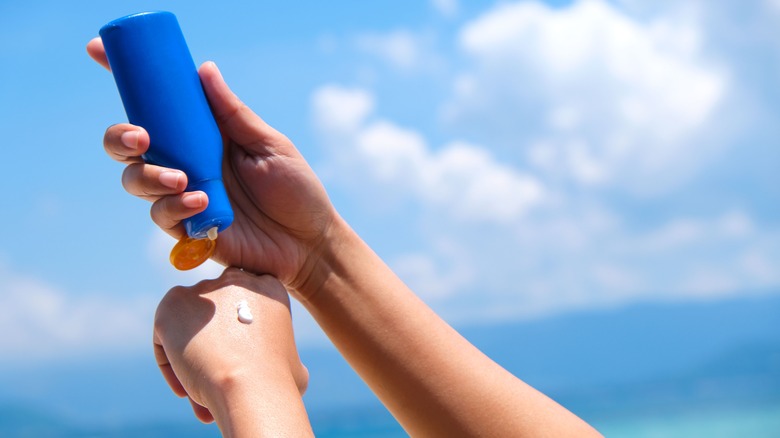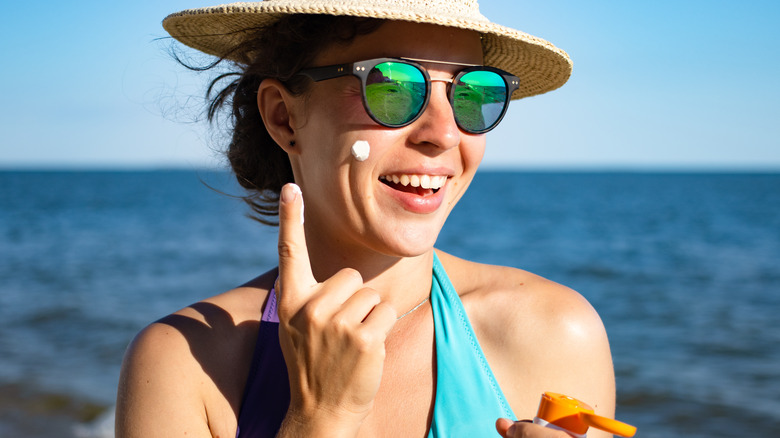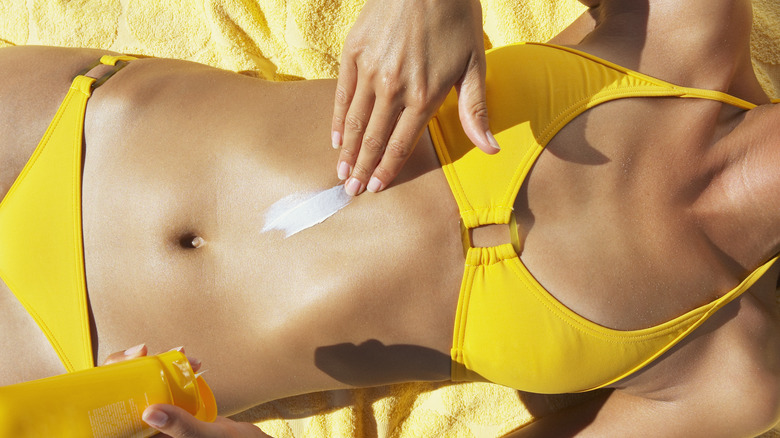These Hard Truths About Tanning Will Scare You Right Into A Bottle Of Sunscreen
It's summertime, and that means heading to the beach with your friends to bathe in the sun. The origin of tanning in the West came about in the 1920s when designer Coco Chanel accidentally tanned in the French Riviera. Since then, tanning has been associated with health and leisure and the rebellious act of doing what one desires in spite of societal norms.
Tanning does come at a price, however. If you're seeking a golden bronze body for the summer, allow us to lay out some risks of sunbathing and effective alternatives to commence your hot girl summer. According to the U.S. Food and Drug Administration (FDA), getting a sunburn as a direct result of tanning is called erythema, or the redness, peeling, and skin damage that can be caused by UV exposure. And that unsightly peeling is nothing compared to the dangerous long-term consequences of baking in the sun.
While there are multiple reasons why indoor and outdoor tanning is harmful — think premature aging and skin cancer – you can still have fun in the sun, as there are a number of ways to combat harmful UV rays, like being diligent about sun protection or deciding sunscreen on your scalp is non-negotiable. Before you enjoy a summer filled with fun in the sun, it's important to be aware of the harmful truths about tanning.
It can increase the risk of skin cancer
According to the Skin Cancer Foundation, getting five or more sunburns doubles your risk of developing melanoma (one of the fastest-growing and most dangerous types of skin cancer). To shock you even more, indoor tanning leads to more cases of skin cancer than smoking leads to lung cancer. One indoor tanning session before the age of 35 can increase your chances of melanoma by a shocking 75%. Despite the harms of tanning, early detection of melanoma has a five-year survival rate of 99%, which is why it's so important to monitor your skin for any changes and bring any concerns you may have to your doctor or dermatologist.
We're not here to scare you but rather help you become more conscious of habits that can lead to harmful long-term effects. If you haven't been using sunscreen already, it's time to get off that tanning bed and start using sun protection daily, no matter where you're going (although we hope it's not to the tanning salon). If you do find yourself with a sunburn, the FDA's recommended treatment includes soaking in a cool bath, using hydrocortisone creams, and taking aspirin or ibuprofen to eliminate pain and inflammation.
It leads to premature aging
Just like sleeping with makeup on, unprotected UV exposure can result in premature aging, or photoaging. While both UVA and UVB rays are harmful, it's UVA rays that result in premature aging. Board-certified dermatologist Dr. Loretta Ciraldo told Allure, "UVA rays penetrate even more deeply and are responsible for most skin aging, hyperpigmentation, damage to collagen fibers, and more aggressive skin cancers including melanomas."
According to Healthline, the high-level wavelengths of UVA radiation can cause a multitude of negative effects, like damage to DNA. Even if you're indoors or if it's a cloudy day, you can still be impacted by UVA rays as windows and clouds are unable to filter them out. But using the right sunscreen can help keep you protected.
Rather than picking up any sunscreen with the highest SPF, find a broad-spectrum sunscreen that can help fight off UVB and UVA rays. "In an optimal sunscreen formula, photo-stabilizers, emollients and antioxidants all contribute to the SPF value, spreadability, and stability of the final formulation," Dr. Ciraldo told Allure.
Your immune system can be compromised
In addition to the external effects of tanning, harmful UV rays can internally damage your body's immune system and the skin's natural defense mechanisms. According to WebMD, small bits of sun exposure can increase vitamin D, which is essential for helping to boost your immune system. But too much sun that results in a sunburn triggers your body's infection-fighting white blood cells to help heal the sunburn, which can potentially leave you less protected from illness-causing germs.
According to the U.S. Environmental Protection Agency, the skin, which is an important part of your immune system, usually does a good job of being the first line of defense against infections and certain cancers. But too many UV rays resulting in sun-damaged skin cannot properly protect you as it normally would. So while a little bit of fun in the sun is good for you, if you spend too much time without being protected, you may be compromising your health.
There are ways to protect your skin against the sun's damage
Don't worry — there are ways to protect yourself from sun damage. Carrying Korean sunscreen everywhere with you can help protect your skin in the gentlest and most multifunctional of ways. While sunscreen products in the U.S. are all made from similar formulas, Korean sunscreen uses a PA system, or a protection grade of UVA rays. Korean sunscreen is also inclusive of skin color, which helps to avoid the white cast that many people of color are forced to live with when applying sunscreen.
Additionally, there are sunless tanning options to help you achieve a bronze glow without putting yourself in harm's way. Spray tanning, lotions, and drops are just a few ways that you can self-tan in a healthy yet effective way. "Look for options with dihydroxyacetone," double-board-certified dermatologist Dr. Karan Lal explained to Glamour. "This binds to dead skin cells and causes a temporary darkening of your skin, and it's FDA-approved." We want you to live your best life this summer, but that means being protective of your skin. You'll be grateful in the long run.




